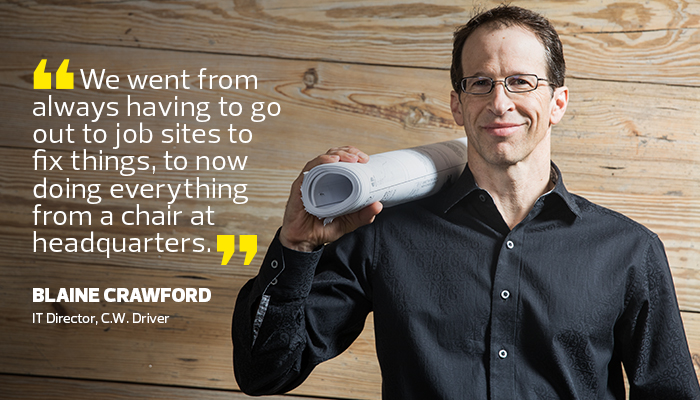Businesses Transform Their Wi-Fi Management in the Cloud
When Blaine Crawford joined C.W. Driver as IT director five years ago, the Pasadena, Calif.-based builder’s IT network was a “big mess of disparate equipment and systems,” he says.
With seven regional offices, C.W. Driver has at least 60 active construction sites at any given time, each of which requires robust wireless connectivity. Previously, that meant the company’s IT staff was often tied up traveling from site to site, configuring access points and troubleshooting when problems arose. But today, Crawford says, the wireless network requires so little onsite attention that he sends his team on site visits simply to remind users that the IT staff is there to help, whenever needed.
The difference: C.W. Driver upgraded to a software-defined WAN and cloud-managed wireless network from Cisco Meraki.
“We’re sending people out to the job sites just to show them that, ‘Hey, we’re here. Yes, we do care,’” laughs Crawford. “We’ve had to do a little bit of a PR campaign. It’s funny, because we went from always having to go out to job sites to fix things, to now doing everything from a chair at headquarters.”
While the increased visibility and ease of management enabled by cloud-managed Wi-Fi systems are attractive to many different types of organizations, this value is multiplied for companies like C.W. Driver, which must support geographically dispersed users across a number of disparate job sites — most of which have no dedicated IT staff.
“We see sort of a sweet spot for organizations that have a distributed enterprise infrastructure,” says Brandon Butler, senior research analyst in the network infrastructure group at IDC. “If you have centralized IT operations, but a lot of distributed locations you want to manage, it makes sense to do that from the cloud.”
While cloud-managed Wi-Fi is experiencing steady growth, Butler says that it is likely to remain less common than on-premises solutions for the foreseeable future. In 2017, cloud-managed solutions made up just 26 percent of the worldwide wireless LAN market, he says. IDC estimates that this number will grow to 30 percent this year, and will hit 38 percent in 2021.
SIGN UP: Get more news from the BizTech newsletter in your inbox every two weeks!
Cloud-Managed Wi-Fi Offers IT Teams Instant Configuration
Users of cloud-managed Wi-Fi solutions consistently cite the plug-and-play configuration of access points as one of the principal advantages of the solutions. “You plug in the AP, you activate it on the Meraki network, you push a license out to it, and you associate it with your SSIDs,” says Crawford. “It’s literally minutes from the time you unbox it and plug it in.”

Perhaps even more important, though, is the ability to remotely manage the wireless network from a central location. “Many times, we’ll get calls from job sites saying, ‘The network is slow, what’s going on?’” Crawford says. “We can jump into the Meraki console and see that we may have a contractor doing some massive download, or an infected computer sending out a blast of data. We can just disconnect the machine from the network, right on the spot.”
San Diego-based Chuze Fitness operates about two dozen health clubs across three states, but the organization lacks onsite IT staffing at nearly all of its branches, and co-founder Kris Peterson serves as both CIO and chief marketing officer for the company.
Before upgrading to Ruckus Cloud Wi-Fi, Peterson says, he and other staffers lacked the ability to troubleshoot problems from headquarters.
“When the Wi-Fi went down, lord, would we hear about it,” Peterson says. “People like coming in, listening to music, watching YouTube — that can be a make or break for a lot of people. But we had to do a lot of over-the-phone troubleshooting, including three-way calling between us, the branch and the service provider. Sometimes it would take a couple of days to get a technician out to a site.”
Now, though, Peterson says, Chuze can throttle the connection speeds of users who engage in intensive movies. The organization has also configured the system to automatically disconnect users after 60 minutes, freeing up seats on the APs. “Before, I felt like every week we were getting a call about our Wi-Fi,” Peterson says. “A lot of those issues have vanished. We’ve gotten to a point where what we’re providing is a lot more reliable and steady.”
Businesses Gain Increased Network Visibility
Before insurance company Penn Mutual adopted cloud-managed Wi-Fi from Cisco Meraki several years ago, its IT shop was “in a crucible,” says Enterprise Networking Director Andy McInerney. The existing legacy network was antiquated, he says, and wireless network management processes were “cumbersome, rudimentary and archaic.”
“You had to be really skilled to squeeze out some analysis, and even then, it was really basic,” he says.
Fast-forward to today, and the IT staff at Penn Mutual’s Horsham, Pa., headquarters can instantly see what’s happening on the network across the company’s nearly 60 local offices around the country.
“You jump on the console, and it pops right out at you,” says McInerney. “You can see everything about that user, that machine, what applications they’re hitting. You can create policies to curtail application-based issues. It’s an incredible amount of data that’s easy to see and digest, and that allows you to troubleshoot.”
IDC’s Butler says this increased visibility does more than just simplify network management. It also helps organizations plan out their entire network strategies.
“We’re increasingly seeing vendors talk about machine learning to predict future usage patterns,” he says. “That’s not to say that can’t be done on-premises, but it’s typically easier for cloud-managed systems, because they’re updated more frequently.”

Data from cloud-managed Wi-Fi systems is already helping to provide automated, push-button resolution for technical issues, Butler says. He adds that “the next logical step” would be data-powered network solutions that provide fully automated resolutions to problems.
Crawford says that C.W. Driver’s move to a unified, cloud-managed wireless network has resulted in a complete 180 for the IT staff — taking them from an environment where technicians scrambled to locate the passwords needed to troubleshoot network components, to one with point-and-click resolution from a central management portal.
“We have so much insight into the traffic that’s going across those access points,” Crawford says. “The wealth of information that’s available to us now is unparalleled.









